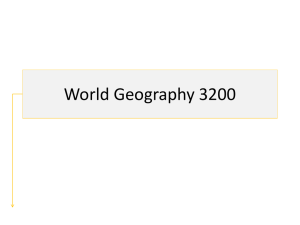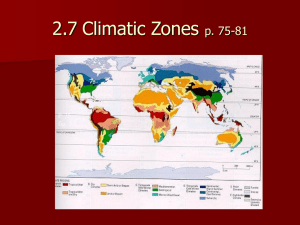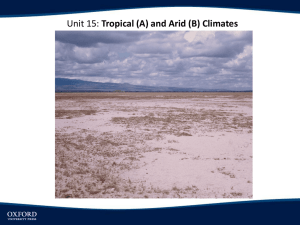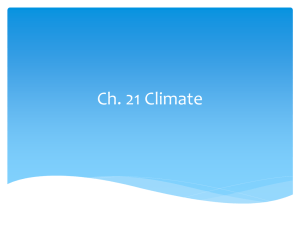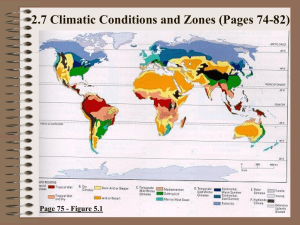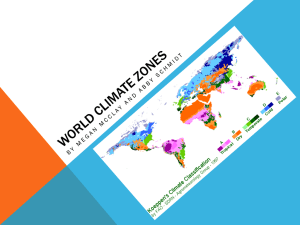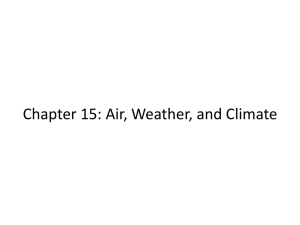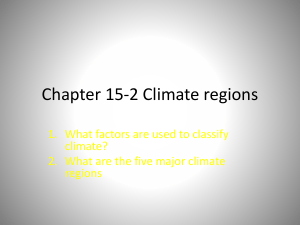Slides 2.6 Elevation and Climate
advertisement
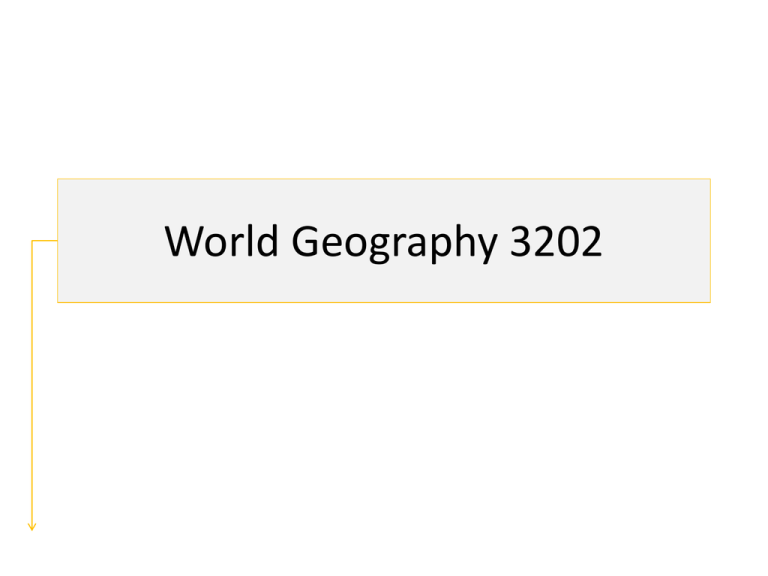
World Geography 3202 Unit 2: Patterns in Weather & Climate Chapter 4 WEATHER AND CLIMATE Weather & Climate Key Terms 1. Weather – the state of the atmosphere at any one place or time, this includes humidity, temperature, hours of sunshine, cloud clover, visibility, and precipitation 2. Climate – the average weather conditions of a region. The recorded average is the result of many years of observations of weather. Climate Graphs Climate Graphs • The right scale indicates the temperature and it is graphed as a line (red is common). • The left scale is for precipitation and is graphed as a bar graph ( blue is common). Elevation and Temperature 2.6 • Elevation is defined as the height of a region above sea level • Air temperature decreases 2ºC for every 300 m increase in elevation. • The higher up we go the colder it gets (hence snow on mountain tops) Impact of Elevation and Temperature. For Example: • La Paz, Bolivia, has an elevation of 3600m. Its coldest month has an average temperature of 9ºC. • Rio de Janeiro, Brazil, has an elevation of 61m. Its coldest month has an average temperature of 25ºC. • La Paz and Rio de Janeiro have a similar distance from ocean and similar latitude. However, La Paz is much colder because of higher elevation. Elevation and Precipitation Relief has an effect on precipitation mostly as it relates to relief rain. Consequently it must be accompanied by wind. Relief Rainfall • Moisture laden air blows off the sea; • it is forced up by mountains (high relief); • air cools at higher altitudes; • cool air holds less moisture; • clouds condense and rain falls; • most rain falls on the windward side of the relief. Rain Shadow • The Leeward side of a mountain is often in a dry rain shadow because the moisture has all been lost. Examples • Many places like Vancouver receive large amounts of rain because they are on the windward side of the mountain. • Other places like Edmonton receive very little rain because they are on the leeward side of a mountain range. Climate Regions 2.7 Tropical Climates • All Tropical Climates have average temperatures over 18C every day due to low latitude, warm ocean currents & prevailing winds. • Viewing figure 5.1 on page 75 of your text you can see that almost all of the tropical wet and the tropical wet & dry climates are located between the tropic of cancer and the tropic of Capricorn. • You will notice on the climate graphs below that the line indicating temperature is fairly flat, right around 20C. – Tropical wet: • heavy rain all year due to hot temp & resulting convectional rain – Tropical wet & dry: • very heavy summer rain & very dry winter due to seasonal shift in prevailing winds. (monsoon regions) Dry Climates • All Dry climates receive less than 500mm precipitation annually. • The region has more evaporation than precipitation leaving it in a water deficit. • There is little vegetation & it is often windy • Climate graphs of arid and semi-arid regions are difficult to distinguish from each other but easy to distinguish from all other climates because of the low precipitation bars. – Semi-Arid or Steppe: • transition zone between desert & Forest. They receive 250-500mm rain annually which is often enough to support grasses but not forests – Arid or Desert: • occur mostly between 10 - 30N & 10 30S and receive 10 - 250mm rain annually Temperate Mild Winter Climates • A review of figure 5.1 on page 75 of your text reveals that temperate mild climates occur in both hemispheres • Temperature varies with seasons • Mid Latitudes • Mild winter • Summer temperatures vary but winters are warmer than –3 C • The distinguishing feature on a climate graph is the curved temperature line – Mediterranean: • occurs in areas around the Mediterranean sea, as well as in small west coast areas of California, Chile, South Africa, and Australia – Subtropical: • This is the climatic region of Florida and other parts of the American southeast, as well as a large part of southeast China and South America – Marine West Coast: • It is found on the west coasts, in high latitudes, extending as far north as Alaska and north Scandinavia, and far south as New Zealand and the southern tip of South America Temperate Cold Winter Climates • A review of figure 5.1 on page 75 of your text reveals that temperate cold climates only occur in the northern Hemisphere. • Temperate cold Winter • Temperature varies with seasons • Mid-high Latitudes • cold winters • Summer temperatures vary but winters are colder than –3 C • The distinguishing feature on a climate graph is the curved temperature line. – Continental, Warm/Cool Summer: • Occurs in much of southern Canada, the American Midwest, all of New England, much of northern Asia, and central Europe – Subarctic: • Follows the same patterns as continental climates, however, the main difference is that winters are very long and extremely cold Polar Climates • Polar climates are distinguished by their extremely low winter temperatures and low summer temperatures. • On the northern edge of North America, Europe, and Asia, as well as throughout Antarctica. • These locations have Earth’s coldest, driest, and darkest winters. – Tundra: • This sub-region is closer to oceans, therefore have less severe temperatures – Icecap: • This sub-region is inland thus with increased cold brought about by continentality Highland Climates • These climates are only characterized by their elevation and decreased temperature because of that. However the climates vary with latitude of the mountain, closeness to the ocean etc. • Some alpine regions can be like the tundra and the ice cap of a mountain is like the polar ice caps. – Upland: • Chiefly characterized by the colder conditions caused by high elevation (above 1000 m). Climatic Conditions & Human Activity 2.8 Positive Influences of Climate • Good tourist industry in subtropics like Florida; • sports are affected: golf—summer, hockey— winter; • religious tradition of Christmas strongly associated with winter conditions; • clothes—fashion changes with the season; • school closed during summer season in temperate zone. Negative Influences of Climate • Transportation is affected; • winter tires in temperate zone; • snow clearing budgets can be high; • school closed during winter storms in temperate zone. Global Warming • Global warming is the gradual increase of the earth's average temperature since the industrial revolution. • It is a fact that the earth's average temperature is increasing. The negative effects associated with global warming are also factual. • Some scientists dispute the fact that it is due to human activity. Some scientists believe the recent increase in temperature is a part of the normal rhythms of change in the earth's atmosphere. Global Warming vs. Greenhouse Effect • It is also important to draw a distinction between global warming and the greenhouse effect. • The greenhouse effect is a good thing and moderates our temperatures here on earth. It operates by specific gases like carbon dioxide and methane. • Global warming is due to the human activity that has increased the level of these greenhouse gasses and consequently increased the earth's temperature. Human Impact on Greenhouse Gases It is believed that humans have changed the balance of greenhouse gasses in the atmosphere in two ways: 1. Increased carbon dioxide emissions due to the combustion of fossil fuels. Coal, Gasoline, Furnace oil, Propane, diesel, and jet fuel are all examples of fossil fuels we burn and result in carbon dioxide emissions. 2. Cutting forests which results in fewer trees. Trees and all plants recycle carbon dioxide into carbohydrates consequently reducing atmospheric carbon dioxide. When these trees are removed the level of carbon dioxide in the atmosphere increases. Global Warming & Climate Change Obviously global warming results in temperature changes. However that temperature change affects precipitation as well. In some areas it increases precipitation and in other areas it reduces precipitation.
